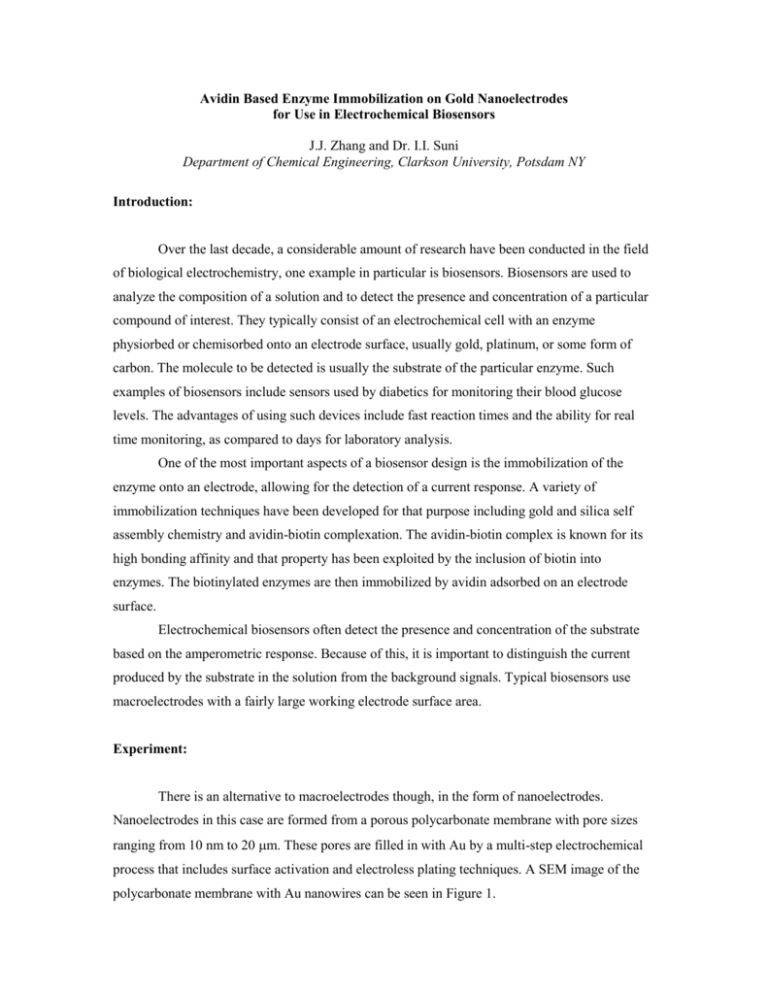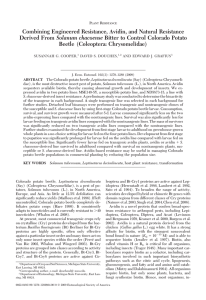Avidin Based Enzyme Immobilization on Gold Nanoelectrodes
advertisement

Avidin Based Enzyme Immobilization on Gold Nanoelectrodes for Use in Electrochemical Biosensors J.J. Zhang and Dr. I.I. Suni Department of Chemical Engineering, Clarkson University, Potsdam NY Introduction: Over the last decade, a considerable amount of research have been conducted in the field of biological electrochemistry, one example in particular is biosensors. Biosensors are used to analyze the composition of a solution and to detect the presence and concentration of a particular compound of interest. They typically consist of an electrochemical cell with an enzyme physiorbed or chemisorbed onto an electrode surface, usually gold, platinum, or some form of carbon. The molecule to be detected is usually the substrate of the particular enzyme. Such examples of biosensors include sensors used by diabetics for monitoring their blood glucose levels. The advantages of using such devices include fast reaction times and the ability for real time monitoring, as compared to days for laboratory analysis. One of the most important aspects of a biosensor design is the immobilization of the enzyme onto an electrode, allowing for the detection of a current response. A variety of immobilization techniques have been developed for that purpose including gold and silica self assembly chemistry and avidin-biotin complexation. The avidin-biotin complex is known for its high bonding affinity and that property has been exploited by the inclusion of biotin into enzymes. The biotinylated enzymes are then immobilized by avidin adsorbed on an electrode surface. Electrochemical biosensors often detect the presence and concentration of the substrate based on the amperometric response. Because of this, it is important to distinguish the current produced by the substrate in the solution from the background signals. Typical biosensors use macroelectrodes with a fairly large working electrode surface area. Experiment: There is an alternative to macroelectrodes though, in the form of nanoelectrodes. Nanoelectrodes in this case are formed from a porous polycarbonate membrane with pore sizes ranging from 10 nm to 20 m. These pores are filled in with Au by a multi-step electrochemical process that includes surface activation and electroless plating techniques. A SEM image of the polycarbonate membrane with Au nanowires can be seen in Figure 1. The membranes are treated and polished such that the surface can be used as an active electrode surface. These nanoelectrodes were constructed using an adapted nanoelectrode fabrication method1 and are available through the efforts of Clarkson researchers.2 The nanoelectrodes provide significant advantages over macroelectrodes and have considerable promise in biosensor applications. One of the most important advantages is the reduction in detection limit. Research has shown ensembles containing 10 nm diameter Au disks have detection limits as much as 3 orders of magnitude lower than large diameter macroelectrodes.3 This can significantly boost the accuracy and sensitivity of biosensors if nanoelectrodes are employed, offering the potential for single molecule detection. The first step will be the immobilization of an avidin and biotinlyated enzyme, glucose oxidase in this case, onto a normal Au macro electrode to evaluate and assess the immobilization. The deposition of avidin consists of immersing an electrode surface in an avidin solution to form a layer of adsorbed avidin and treated such that only strongly adsorbed avidin remains. The electrode is then exposed to a solution containing the biotinylated glucose oxidase to allow for complexing. Formation of multi-layer avidin-biotin complexes may be required to obtain a significant amperometric response. If successful, the experiment will be redone using the polycarbonate Au nanoelectrodes. Data will be collected by experimentation using a three-electrode cell and analyzed using cyclic voltammetry. Cyclic voltammetry involves application of a voltage ramp to the biosensor interface and simultaneous detection of the current response. The three-electrode cell is composed of an electrode surface with avidin-biotinylated glucose oxidase adsorbed onto the surface, a SCE reference electrode, and a platinum wire counter electrode. The electrode activity will be monitored using a potentiostat. The data from the electrodes will be analyzed and assessed for its potential use in biosensors. The analysis will be done by comparing detection limits, substrate concentration resolution, and signal-noise quality. 1 Vinod P. Menon and Charles R. Martin, "Fabrication and evaluations of nanoelectrode ensembles," Anal. Chem. 67,1920 (1995). 2 Dr. Ian Suni, Dr. Igor Sokolov, and Jianbin Wang. Clarkson University. 3 Tomonori Hoshi, Jun-ichi Anzai, and Tetsuo Osa, "Controlled Deposition of Glucose Oxidase on Platinum Electrode Based on an Avidin/Biotin System for the Regulation of Output Current of Glucose Sensors," Anal. Chem. 67, 770 (1995).








